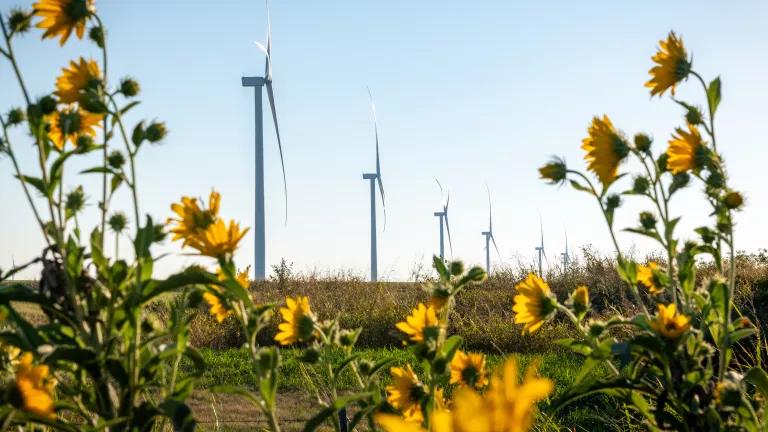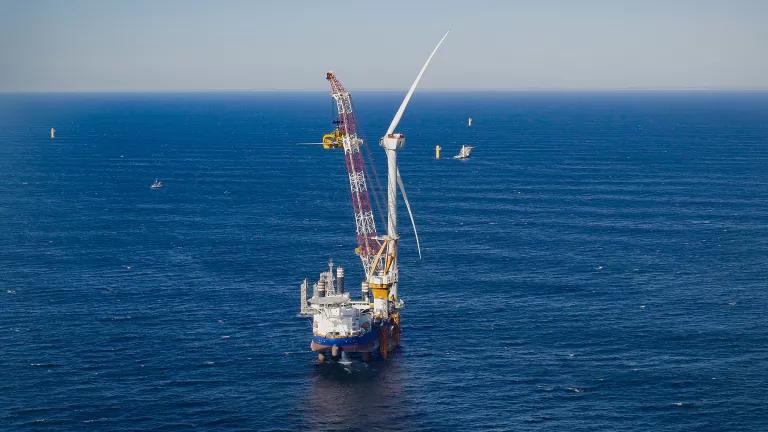The History and Future of Renewables Rhyme with Growth
What’s old is new again! Clean energy is making our world cleaner and greener.

Part of NRDC's Year-End Series Reviewing 2020 Climate & Clean Energy Developments
Mark Twain supposedly said, “history doesn't repeat itself, but It often rhymes.” On the cusp of 2021, here are three rhyming examples from the world of renewables: green hydrogen, offshore wind and renewable energy jobs. What’s old is new again! Clean energy is making our world cleaner and greener.
Green Hydrogen
As the need to decarbonize our entire economy becomes ever clearer, green hydrogen has come back to center stage. In the 90’s, hydrogen was looked to power our phones, homes, businesses and cars. Today wind and solar power, batteries and electric cars have all become dramatically cheaper, and hydrogen is being looked at for long-term renewable storage and moving industrial process energy off of fossil fuels. We used to think that we could wait to worry about industry’s need for high-heat process energy and how to run our grid on 100 percent renewables, but the climate crisis is now. Green hydrogen is very promising for those hard to electrify processes.
In 2020, Europe committed $500 billion to a mostly green hydrogen plan, and momentum started growing in the U.S. with announced green hydrogen projects in Arkansas, Louisiana, Mississippi, and Texas, new regional hydrogen initiatives and federal level policy documents. You can read more about green hydrogen and how to get it right from the start in my colleague Rachel Fakhry’s blogs here and here.
Offshore Wind
In 2000, the first offshore wind project was proposed in the U.S.—the ill-fated Cape Wind project. Before eventually failing, it faced three different permitting regimes. Now, once again, we’re on the cusp of the first utility scale offshore wind project being approved.
In 2020, the Vineyard Wind project grappled with delays and setbacks at the hands of the Trump administration but still got within days of an approval. At the last minute, the company decided on a new larger turbine and pulled its permit application to update it. The Trump administration continues to play politics to try to kill or delay it, arguing that Vineyard needs to start all over, but that decision soon will be up to the Biden administration.
So, one of its first acts hopefully will be getting Vineyard Wind back on track and approving this 800MW project that will produce enough energy to power 400,000 homes. Then the Biden team can move on to the roughly 10 other offshore wind projects that await federal approval. Done right, they will create thousands of jobs, revitalize diverse port communities, and be sited and built to be protective of marine ecosystems When this first wave of projects is online, they will provide enough clean, renewable electricity to power between 5 and 10 million homes.
Renewable Energy Jobs
The Obama-Biden administration inherited the great recession in 2009 and decided to focus on clean energy to power the economic recovery. Jobs in the wind and solar industry sector soared while costs plummeted. Renewable energy employment grew by about 28 percent between 2015 and 2019 (from about 420,000 to about 540,000 jobs). In the last decade, wind and solar costs have come down by 65 percent.
Tragically in 2020, renewable energy workers suffered in the pandemic recession. Currently 70,000 workers remain unemployed or more than 12 percent of the workforce. But growth of renewable energy has continued. In 2020, solar and wind energy provided 11 percent of our electricity for the first time. The U.S. installed a record 37 GW of wind and solar capacity in 2020, more than double the previous high set in 2016.
As President-elect Biden inherits a second economic collapse, he’s indicated that he’s focusing on clean energy to lift the economy, grow jobs and maximize the benefits of the renewable sector. My colleagues have written about the best ways Biden can fight the climate crisis, move us off fossil fuels and grow the clean energy economy. Energy efficiency, electric cars, batteries, solar and onshore wind are shovel ready and can put hundreds of thousands of people back to work.
There can also be lots of jobs in green hydrogen and offshore wind in 2021 and even more in the decades to come if we do it right. Scientists and innovators are needed to overcome the challenges of producing and distributing hydrogen. Cement, iron, steel and chemicals are the largest industrial users of fossil fuels for process energy and are responsible for about 3 percent of U.S. greenhouse gas pollution. If green hydrogen proves to be a good solution for industry and a way to store wind and solar across seasons, the hydrogen fuel industry will grow from effectively zero to about 9 million tonnes by 2050—about equal to today’s total annual U.S. hydrogen consumption. That’s decades of new jobs!
For offshore wind, steel, cement and other construction trades are needed right now to build offshore wind turbines and upgrade our ports. The scale of the potential is huge. States along the Atlantic Coast have committed to buying 30,000MW of offshore wind by 2035. The U.S. could easily produce three or four times that by 2050. That’s economic growth!
2021 promises to be the year the U.S. gets back in the climate game at the federal level, and the second time the clean energy economy plays a central role in putting America back to work. But remember the rhyme started years ago, and it’s going to keep growing bigger and better.




